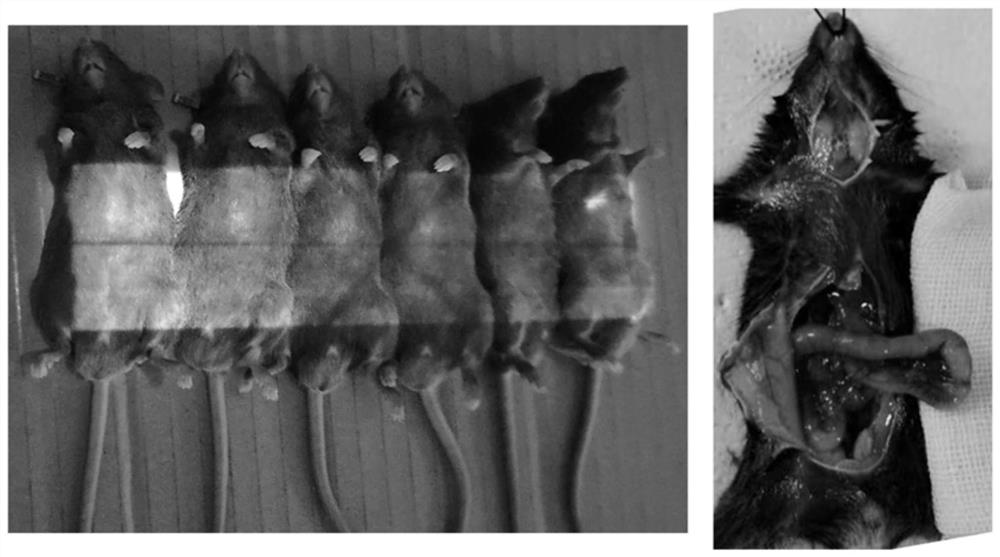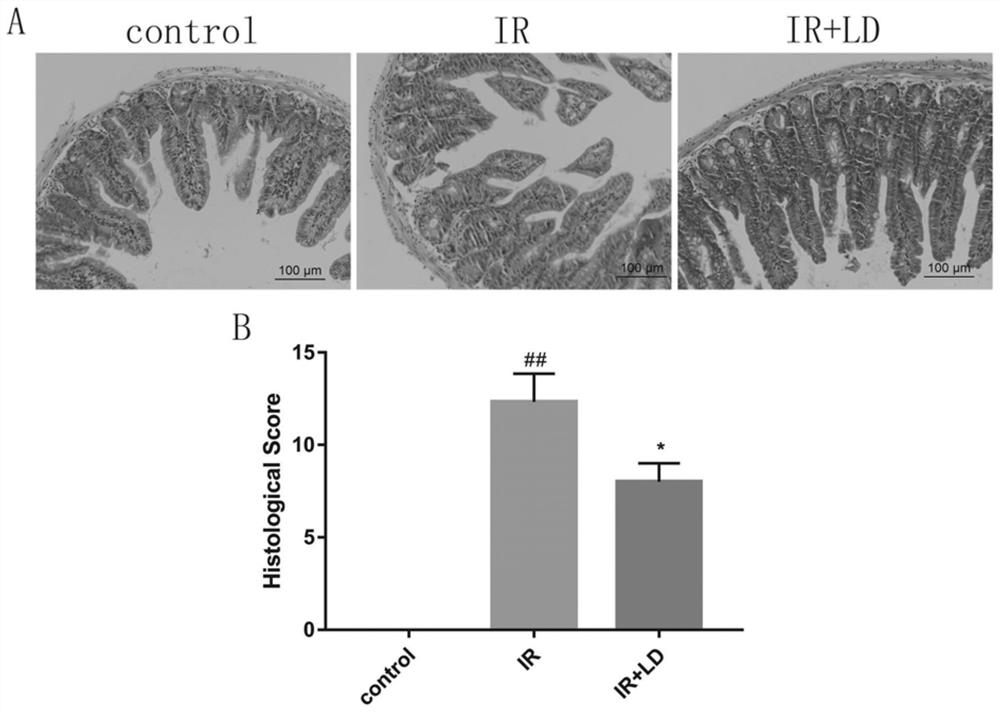Application of liriodendrin in medicine for treating radiation enteritis
A technology of radiation enteritis and lirioside, which is applied in the field of plant components in the treatment of diseases, can solve problems such as limited effects, and achieve the effect of broad clinical application prospects
- Summary
- Abstract
- Description
- Claims
- Application Information
AI Technical Summary
Problems solved by technology
Method used
Image
Examples
Embodiment 1
[0032] Establishment of radiation enteritis model
[0033] After the female C57BL / 6J mice were anesthetized, they were irradiated locally with Co60 gamma rays at 8Gy, using a GWXJ80 co-60 radiotherapy apparatus with an output dose of 39.22Gy / min to establish a radiation enteritis model (see attached figure 1 shown). The mice were randomly divided into a blank control group (control group), a model group (IR group), and a drug treatment group (IR+LD group, turioside concentration 100 mg / Kg), with 6 mice in each group. The mice in the IR+LD group were intragastrically administered with corresponding doses of turioside 3 days before irradiation and continued until the end of the experiment, and the control group and IR group were given equal volumes of distilled water. The mice in each group were sacrificed after 7 days. Table 1 below shows the reagents used in this example and their sources.
[0034] Table 1 Reagents required for model building
[0035] Reagent nam...
experiment example 1
[0038] H&E staining to evaluate the grade of enteritis tissue injury
[0039]After the treatment, the mice were sacrificed by cervical dislocation, the abdomen was opened to expose the ileocecal part, the proximal ileum was removed, and the intestinal secretions were rinsed with pre-cooled normal saline. About 0.5 cm of the ileum was taken from the ileocecal and fixed with 10% formalin solution for H&E staining. Reagents related to H&E staining are listed in Table 2 below.
[0040] The operation steps are:
[0041] 1. Making Paraffin Sections of Intestinal Tissue
[0042] Fix the ileal tissue with 4% paraformaldehyde solution for 24 hours; soak the fixed intestinal tissue in different concentrations of ethanol for 30 minutes; then use xylene and absolute ethanol (1:1) to soak for 2 hours; Xylene I and II respectively for 1.5 hours; then soaked in different paraffins, put the intestinal tissue soaked in wax into the tissue embedding box, pour the melted paraffin in the machi...
experiment example 2
[0054] Sphingolipidome analysis of mouse intestinal tissue (Cer, Cer1P, S1P)
[0055] Lirioside can alleviate intestinal pathological damage in mice, and detect the changes of Cer, Cer1P, and S1P through the sphingolipid pathway, suggesting that Lirioside plays an anti-inflammatory and anti-apoptotic role.
[0056] The operation steps are:
[0057] The collected ileal tissues were frozen in liquid nitrogen, and 5 samples from each group were randomly selected, a total of 15 samples from three groups were stored on dry ice and sent to Changzhou Zhongke Zhidian Biotechnology Co., Ltd. for sphingolipid group analysis. The company extracts lipids from the samples using a modified Bligh / Dyer extraction method (two extractions). Samples were reconstituted in isotope mix and all analyzes were performed using an ExionUPLC-QTRAP 6500Plus (Sciex) LC / MS in electrospray ionization (ESI) mode. Using Phenomenex Luna silica 3μm (inner diameter 150x2.0mm) chromatographic column, various pol...
PUM
 Login to View More
Login to View More Abstract
Description
Claims
Application Information
 Login to View More
Login to View More - R&D
- Intellectual Property
- Life Sciences
- Materials
- Tech Scout
- Unparalleled Data Quality
- Higher Quality Content
- 60% Fewer Hallucinations
Browse by: Latest US Patents, China's latest patents, Technical Efficacy Thesaurus, Application Domain, Technology Topic, Popular Technical Reports.
© 2025 PatSnap. All rights reserved.Legal|Privacy policy|Modern Slavery Act Transparency Statement|Sitemap|About US| Contact US: help@patsnap.com



